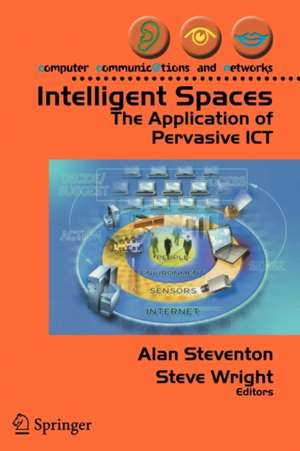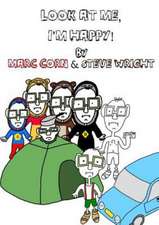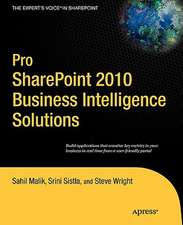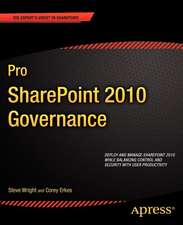Intelligent Spaces: The Application of Pervasive ICT: Computer Communications and Networks
Editat de Alan Steventon, Steve Wrighten Limba Engleză Paperback – 14 feb 2006
Din seria Computer Communications and Networks
- 20%
 Preț: 378.19 lei
Preț: 378.19 lei - 20%
 Preț: 684.74 lei
Preț: 684.74 lei - 20%
 Preț: 218.22 lei
Preț: 218.22 lei - 20%
 Preț: 1013.39 lei
Preț: 1013.39 lei - 20%
 Preț: 368.78 lei
Preț: 368.78 lei - 20%
 Preț: 505.49 lei
Preț: 505.49 lei - 20%
 Preț: 646.80 lei
Preț: 646.80 lei - 20%
 Preț: 609.09 lei
Preț: 609.09 lei - 20%
 Preț: 765.60 lei
Preț: 765.60 lei - 20%
 Preț: 339.47 lei
Preț: 339.47 lei - 20%
 Preț: 597.29 lei
Preț: 597.29 lei - 20%
 Preț: 655.85 lei
Preț: 655.85 lei - 20%
 Preț: 997.06 lei
Preț: 997.06 lei - 20%
 Preț: 351.89 lei
Preț: 351.89 lei - 20%
 Preț: 902.04 lei
Preț: 902.04 lei - 20%
 Preț: 996.22 lei
Preț: 996.22 lei - 20%
 Preț: 644.81 lei
Preț: 644.81 lei - 15%
 Preț: 650.69 lei
Preț: 650.69 lei - 20%
 Preț: 650.73 lei
Preț: 650.73 lei - 20%
 Preț: 373.91 lei
Preț: 373.91 lei - 20%
 Preț: 646.95 lei
Preț: 646.95 lei - 20%
 Preț: 1004.99 lei
Preț: 1004.99 lei - 20%
 Preț: 646.80 lei
Preț: 646.80 lei - 20%
 Preț: 341.81 lei
Preț: 341.81 lei - 20%
 Preț: 656.19 lei
Preț: 656.19 lei - 20%
 Preț: 651.75 lei
Preț: 651.75 lei - 20%
 Preț: 331.08 lei
Preț: 331.08 lei - 20%
 Preț: 650.40 lei
Preț: 650.40 lei - 20%
 Preț: 988.66 lei
Preț: 988.66 lei - 20%
 Preț: 643.97 lei
Preț: 643.97 lei - 20%
 Preț: 761.44 lei
Preț: 761.44 lei - 20%
 Preț: 332.71 lei
Preț: 332.71 lei - 20%
 Preț: 345.59 lei
Preț: 345.59 lei - 20%
 Preț: 332.06 lei
Preț: 332.06 lei - 20%
 Preț: 996.22 lei
Preț: 996.22 lei - 20%
 Preț: 644.15 lei
Preț: 644.15 lei - 20%
 Preț: 326.64 lei
Preț: 326.64 lei - 20%
 Preț: 320.19 lei
Preț: 320.19 lei - 20%
 Preț: 1013.06 lei
Preț: 1013.06 lei - 20%
 Preț: 642.52 lei
Preț: 642.52 lei - 20%
 Preț: 641.01 lei
Preț: 641.01 lei - 20%
 Preț: 718.56 lei
Preț: 718.56 lei - 20%
 Preț: 1043.41 lei
Preț: 1043.41 lei
Preț: 653.71 lei
Preț vechi: 817.14 lei
-20% Nou
Puncte Express: 981
Preț estimativ în valută:
125.13€ • 135.96$ • 105.17£
125.13€ • 135.96$ • 105.17£
Carte tipărită la comandă
Livrare economică 22 aprilie-06 mai
Preluare comenzi: 021 569.72.76
Specificații
ISBN-13: 9781846280023
ISBN-10: 1846280028
Pagini: 449
Ilustrații: XVIII, 432 p. 162 illus.
Dimensiuni: 155 x 235 x 20 mm
Greutate: 0.64 kg
Ediția:2006
Editura: SPRINGER LONDON
Colecția Springer
Seria Computer Communications and Networks
Locul publicării:London, United Kingdom
ISBN-10: 1846280028
Pagini: 449
Ilustrații: XVIII, 432 p. 162 illus.
Dimensiuni: 155 x 235 x 20 mm
Greutate: 0.64 kg
Ediția:2006
Editura: SPRINGER LONDON
Colecția Springer
Seria Computer Communications and Networks
Locul publicării:London, United Kingdom
Public țintă
ResearchCuprins
Intelligent Spaces — The Vision,the Opportunities, and the Barriers.- The Socio-Economic Impact of Pervasive Computing — Intelligent Spaces and the Organisation of Business.- No Pervasive Computing Without Intelligent Systems.- The Supply Chain.- Care in the Community.- Pervasive Home Environments.- Traffimatics — Intelligent Co-operative Vehicle Highway Systems.- Mixed-Reality Applications in Urban Environments.- A Sensor Network for Glaciers.- Co-operation in the Digital Age — Engendering Trust in Electronic Environments.- Maintaining Privacy in Pervasive Computing — Enabling Acceptance of Sensor-based Services.- RFID Security and Privacy — Issues, Standards, and Solutions.- Ambient Technology — Now You See It, Now You Don’t.- Integrated Sensor Networks for Monitoring the Health and Well-Being of Vulnerable Individuals.- Segmentation and Tracking of Multiple Moving Objects for Intelligent Video Analysis.- An Attention-based Approach to Content-based Image Retrieval.- Eye Tracking asa New Interface for Image Retrieval.- The Implications of Pervasive Computing on Network Design.- Autonomic Computing for Pervasive ICT — A Whole-System Perspective.- Scale-Free Topology for Pervasive Networks.- NEXUS — Resilient Intelligent Middleware.- Intelligent Data Analysis for Detecting Behaviour Patterns in iSpaces.- xAssist — Inferring User Goals from Observed Actions.- Programming iSpaces — A Tale of Two Paradigms.
Recenzii
Intelligent spaces : the application of pervasive ICT (Computer Communications
and Networks)
Steventon A., Wright S., Springer-Verlag New York, Inc., Secaucus, NJ, 2005. 438 pp.
Type: Book
Date Reviewed: Mar 16 2006
Information and communication technology (ICT) has been around for several years. It
improves the way we compute and communicate, and yet human lives have remained
essentially the same. However, this is about to change. As this book explains, every facet
of human endeavor will be affected and changed (for the better, we hope) by pervasive
ICT, referred to here as intelligent spaces (iSpaces).
The book consists of 24 chapters written by different authors. The topics can be roughly
divided into five parts. The first part introduces the basics of iSpaces: what they are, their
impact, and the science and technology needed behind them. The second part briefly
explains several applications of iSpaces, ranging from supply chain,home, and community
environment to the monitoring of highway traffic and glaciers. The third part discusses
trust, privacy, and security issues in iSpaces. The fourth part is oriented more toward
technology, discussing several implementations of iSpaces. The final part examines the
digital infrastructure that will need to be there in order for iSpaces to work. In general, this
book is well edited and each chapter is concise. However, 24 chapters are a lot to digest
and perhaps the fourth part could have been omitted without affecting the value of the
book too much.
The intended audience for this book is not clear. If meant for the general public, then the
authors could perhaps have focused more on the social impact and changes iSpaces will
bring. Color images would also help to engage readers.
One final question comes to mind: are iSpaces always good for people? Have any disasters
occurred in the past due to pervasive (or some may say invasive) ICT? A chapter or two
discussing real examples of the downside of iSpaces would help this book to be more
complete and insightful.
and Networks)
Steventon A., Wright S., Springer-Verlag New York, Inc., Secaucus, NJ, 2005. 438 pp.
Type: Book
Date Reviewed: Mar 16 2006
Information and communication technology (ICT) has been around for several years. It
improves the way we compute and communicate, and yet human lives have remained
essentially the same. However, this is about to change. As this book explains, every facet
of human endeavor will be affected and changed (for the better, we hope) by pervasive
ICT, referred to here as intelligent spaces (iSpaces).
The book consists of 24 chapters written by different authors. The topics can be roughly
divided into five parts. The first part introduces the basics of iSpaces: what they are, their
impact, and the science and technology needed behind them. The second part briefly
explains several applications of iSpaces, ranging from supply chain,home, and community
environment to the monitoring of highway traffic and glaciers. The third part discusses
trust, privacy, and security issues in iSpaces. The fourth part is oriented more toward
technology, discussing several implementations of iSpaces. The final part examines the
digital infrastructure that will need to be there in order for iSpaces to work. In general, this
book is well edited and each chapter is concise. However, 24 chapters are a lot to digest
and perhaps the fourth part could have been omitted without affecting the value of the
book too much.
The intended audience for this book is not clear. If meant for the general public, then the
authors could perhaps have focused more on the social impact and changes iSpaces will
bring. Color images would also help to engage readers.
One final question comes to mind: are iSpaces always good for people? Have any disasters
occurred in the past due to pervasive (or some may say invasive) ICT? A chapter or two
discussing real examples of the downside of iSpaces would help this book to be more
complete and insightful.
Textul de pe ultima copertă
Intelligent Spaces: The Application of Pervasive ICT sets out a vision where Information & Communication Technology (ICT) moves from the PC on the desktop out into the physical world, and becomes pervasive. The world about us will appear to have real intelligence embedded in it, creating what we term "Intelligent Spaces" or "iSpaces", which will augment and support virtually every human activity.
An iSpace consists of
• The physical world in which the user exists, in his/her relevant context.
• The interface between the digital world and the physical world. This contains embedded sensors to gather data, labels to identify objects, actuators to control things/appliances in the physical world, together with support software to facilitate non-intrusive two-way communication across the interface,
• The digital world in which digital knowledge and intelligent systems are available to intelligently analyse data gathered from the physical world, and to influence and support our actions in that physical world.
Intelligent Spaces: The Application of Pervasive ICT describes the vision and how it has already been demonstrated in a number of applications ranging from the home, healthcare and traffic systems to monitoring glaciers. It identifies many of the technical, human and business issues which need to be researched before the benefits can become widespread, and describes possible solutions to them. Academic & industrial researchers in Computer Science, IT & Communications, as well as practitioners will find this key reading as it delivers practical & implementable current research.
An iSpace consists of
• The physical world in which the user exists, in his/her relevant context.
• The interface between the digital world and the physical world. This contains embedded sensors to gather data, labels to identify objects, actuators to control things/appliances in the physical world, together with support software to facilitate non-intrusive two-way communication across the interface,
• The digital world in which digital knowledge and intelligent systems are available to intelligently analyse data gathered from the physical world, and to influence and support our actions in that physical world.
Intelligent Spaces: The Application of Pervasive ICT describes the vision and how it has already been demonstrated in a number of applications ranging from the home, healthcare and traffic systems to monitoring glaciers. It identifies many of the technical, human and business issues which need to be researched before the benefits can become widespread, and describes possible solutions to them. Academic & industrial researchers in Computer Science, IT & Communications, as well as practitioners will find this key reading as it delivers practical & implementable current research.
Caracteristici
The treatment is based on a single clear vision of what is technically possible and what eventual users of the advances will want or need Broad treatment – from concept to application, tackling R and D technology issues as well as end user and market issues Being driven by a commercial organisation, the various contributions have to be practical and implementable Includes supplementary material: sn.pub/extras
















